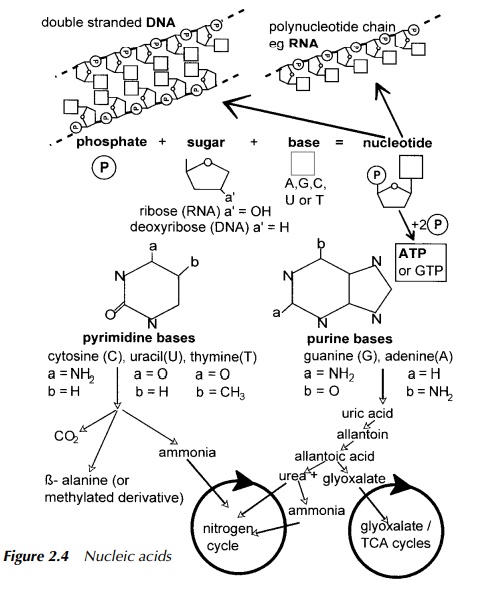Chapter: Environmental Biotechnology: Microbes and Metabolism
Production of Cellular Energy
Production of Cellular Energy
Cellular energy is present mainly in the form of ATP and to a
lesser extent, GTP (Figure 2.4) which are high energy molecules, so called
because a large amount of chemical energy is released on hydrolysis of the
phosphate groups. The energy to make these molecules is derived from the
catabolism of a food, or from photosynthesis. A food source is commonly
carbohydrate, lipid or to a lesser extent, protein but if a compound considered
to be a contaminant can enter a catabolic pathway, then it can become a ‘food’
for the organism. This is the basis of bioremediation. The way in which energy
is transferred from the ‘food’ molecule to ATP may take two substantially different
routes. One is cytoplasmic synthesis of ATP which is the direct transfer of a
phosphate group to ADP, storing the energy of that reaction in chemical bonds.
The other involves a fairly complicated system involving transfer of electrons
and protons, or hydrogen ions, which originated from the oxidation of the
‘food’ at some stage during its passage through the catabolic pathways. The
final sink for the electrons and hydrogen ions is oxygen, in the case of
oxidative phosphorylation, to produce water. This explains the need for good
aeration in many of the processes of environmental biotechnology, where
organisms are using oxidative phosphorylation as their main method for
synthesising ATP. An example of this is the activated sludge process in sewage treatment.
However, many microbes are anaerobes, an example being a class of archaea, the
methanogens, which are obligate anaerobes in that they will die if presented
with an oxygenated atmosphere. This being the case, they are unable to utilise
the oxidative phosphorylation pathways and so instead, operate an electron
transport chain similar in principle, although not in detail.

It has as the ultimate
electron and hydrogen sink, a variety of simple organic compounds including
acetic acid, methanol and carbon dioxide. In this case, the end product is
methane in addition to carbon dioxide or water depending on the identity of the
electron sink. These are the processes responsible for the production of
methane in an anaerobic digester which explains the necessity to exclude air
from the process.
Related Topics